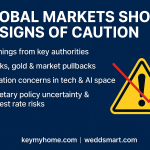Global financial markets are shifting into a more cautious stance as multiple red flags signal elevated risk ahead. After months of bullish momentum, investors are increasingly wary of overheated valuations, monetary policy uncertainties, and geopolitical tensions. While some asset classes continue to rally, the mood has grown more fragile — suggesting that a sharp correction may no longer be a remote scenario.
What’s Driving the Caution?
Warnings from Key Authorities
The Bank of England cautioned that markets could suffer a sharp correction if sentiment sours around AI valuations or doubts emerge over U.S. Fed independence.
Meanwhile, the International Monetary Fund and other global watchers are flagging lofty equity valuations as potentially unsustainable.
Adding to the concern, JPMorgan CEO Jamie Dimon publicly stated he is “far more worried” about a possible U.S. market correction over the next 6 to 24 months.
Stocks, Gold & Market Pullbacks
After a strong run, equities in the U.S. and elsewhere have begun to pause.
Gold — often seen as a refuge during uncertainty — also retreated recently from record highs, as traders reassessed risk appetite.
Valuation Concerns in the Tech & AI Space
Much of the exuberance fueling the rally has centered on tech and AI-driven names, many of which now trade at price-to-earnings multiples reminiscent of past bubbles.
When a few mega-cap stocks dominate index returns, any stumble in those names can ripple across broader markets.
Monetary Policy Uncertainty & Interest Rate Risks
Central banks remain under pressure to balance inflation control with support for growth. Any perceived tilt toward hawkishness or uncertainty about rate paths could rattle markets.
The bond market is also showing jitters: yields and credit spreads are increasingly sensitive to global sentiment shifts.
Geopolitical & External Shocks
Market participants are also keeping a close eye on geopolitical flashpoints — war, trade conflicts, and supply chain disruptions remain latent risks.
Unexpected developments in policy or politics could trigger abrupt reversals.
What Could Unfold Next?
Moderate Correction or Pullback: A 5–10% slide in equities would not be surprising under the current mood, especially if major tech names weaken.
Rotation Among Sectors: Investors may rotate away from high-multiple growth names toward defensive, value, or commodity-linked sectors.
Volatility Spikes: Expect higher intraday swings and increased demand for safe-haven assets (gold, U.S. Treasuries, cash).
Policy Headwinds: Central banks may react defensively — either delaying easing or tightening more than expected — which could prolong uncertainty.
Divergent Market Behavior: Emerging markets, commodity exporters, and less correlated asset classes might decouple from developed-market trends.
What It Means for Investors & Economies
More disciplined portfolio construction will be crucial — avoid overconcentration in any single sector or theme.
Hedging strategies (options, protective stops) might gain appeal.
Asset allocation across global geographies could become more important — diversifying exposure to non-U.S. equities and debt markets could help reduce reliance on one dominant region.
Companies with weak balance sheets or those deeply exposed to interest rates may come under stress first.
For deeper insights, trends, and policy analysis, check out KeyMyHome (https://www.keymyhome.com) and WeddSmart (https://www.weddsmart.com).
Related posts:
Heavy rains triggered destructive floods and landslides in Darjeeling and North Bengal, claiming lives, destroying homes, collapsing roads and bridges, and displacing communities. Rescue efforts are ongoing amid challenging terrain and forecasted rains.
IIT Kanpur’s three-day literary and cultural festival Akshar 2025 began with lectures on Premchand and folk traditions, ghazal performances, storytelling sessions, and musical acts—celebrating India’s linguistic and artistic heritage. Visit KeyMyHome and WeddSmart for more.


 Crushing Rains: Darjeeling & North Bengal Devastated by Floods and Landslides
Crushing Rains: Darjeeling & North Bengal Devastated by Floods and Landslides
 “Akshar 2025” Festival Sparks Literary & Cultural Renaissance at IIT Kanpur
“Akshar 2025” Festival Sparks Literary & Cultural Renaissance at IIT Kanpur
 Global Markets Show Signs of Caution Amid Elevated Risk Sentiment
Global Markets Show Signs of Caution Amid Elevated Risk Sentiment
 UK-India Defence & Trade Deals Deepen Ties: A New Chapter in Strategic Partnership
UK-India Defence & Trade Deals Deepen Ties: A New Chapter in Strategic Partnership
 India Extends Deadline for US LPG Import Tender: Strategic Implications and Challenges
India Extends Deadline for US LPG Import Tender: Strategic Implications and Challenges